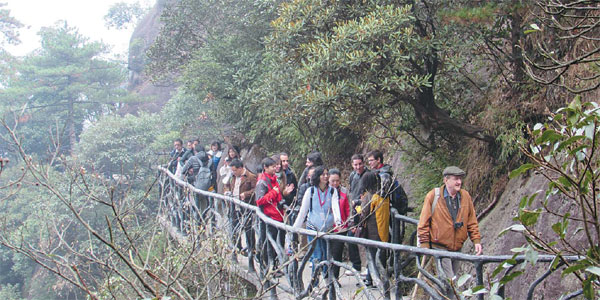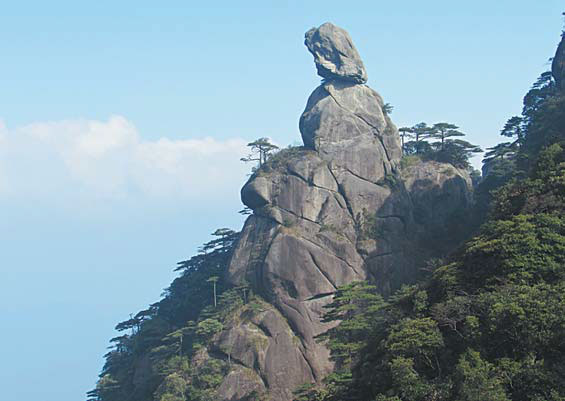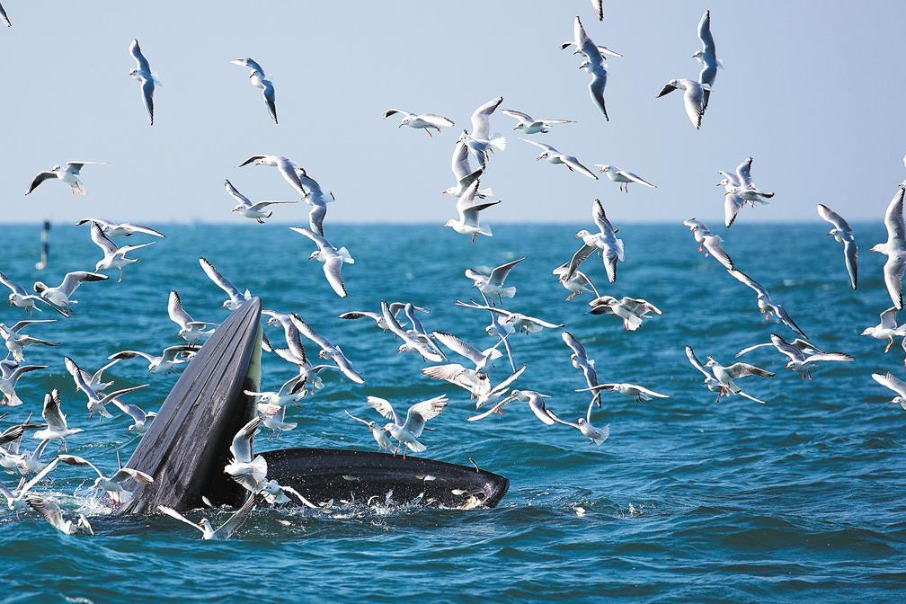Sacred stones, continents apart

Sanqing mountain bears similarities to Crying Stone of Kakemega, a formation sacred to some in Kenya
A recent excursion to the somewhat obscure Sanqing Mountain in Jiangxi province in Southeast China evoked memories of the Crying Stone of Kakamega County in Kenya. I found myself drawing parallels between rock formations at the sites, which are separated by 9,000 kilometers.
Our group of foreign journalists starts our ascent to the acclaimed Land of Peach Blossoms at 10 am via a cable car that rises to 1,400 meters across Mount Sanqingshan National Park. The ride goes over a beautiful, lush valley with rocks and deep gullies. The ride is not for the acrophobic or faint-hearted, as it is not smooth. Every so often it rocks us, especially as it passes by supporting towers.
| Visitors from China and abroad visit Sanqing Mountain. Photos by Philip Etyang / For China Daily |
Within 10 minutes we arrive at Jiasha cable station. I am immediately hit with the change of atmospheric pressure. The air pressure and density is definitely much lower compared with what it was at the foot of the mountain. It is also colder at the top, and my breathing is now more rapid.
Before proceeding with the expedition to the summit, I take time to read a sign with information about the mountain.
The park occupies 756 square kilometers and the highest peak is 1,819 meters above sea level. It has three peaks, Yujing, Yuxu and Yuhua.
"At the 32nd World Heritage Convention in July 2008, Sanqing Mountain Scenic Zone was officially listed into the World Heritage C15 List and became Jiangxi's first and China's seventh World Heritage Site," the board says.
Our able guide, He Li, takes time to explain the religious significance of the site. "To Taoists, Sanqing Mountain is very important. The name Sanqing can loosely be translated to mean 'three pure ones'," she says.
She says the three peaks of the mountain resemble the three deities of Taoism: Yuqing, Shangqing and Taiqing.
Claudia He, director of China programs at the Alliance of Religions and Conservation, later confirms the guide's account.

"The three peaks of the mountain can be compared to the Christian Holy Trinity. One of the peaks represents the Tao. The second one is the creator of the universe while the third peak represents the manager of the universe."
"Those are the three greatest Taoist deities. The highest is the God of Supreme Purity."
With all this information, we now set off for the Nanqing Garden Scenic Spot, the location of a rock statue named the Oriental Goddess, about 300 meters from the cable car station. We walk around the mountain to the spot along a winding concrete footpath lined with indigenous trees and plants.
I decide to finish my excursion at this spot. I take a seat on one of several carved stone seats to marvel at the Oriental Goddess. The rock has a unique structure resembling a woman sitting. The tip of the rock is separated from the rest of the massive structure.
A sign at the site says the 86-meter-high rock was shaped by spheroidal weathering to form the shape of a woman. Spheroidal weathering is a type of chemical reaction that results in the formation of spherical layers of decayed rock that fall off like layers of an onion, often leaving rounded shapes.
This is when I start drawing comparisons with the imposing Crying Stone of Kakamega. The 40-meter formation has similar rocks perched at its apex, and looks like a gowned figure with water flowing from the joint between the two rocks as if it were tears. The Isukha and Idakho sub-tribes of the larger Abaluhya community of Western Kenya traditionally held religious ceremonies at the foot of the Crying Stone. Traditional dances such as Tindikiti, Isukuti and Litungu are from time to time held at the site, with residents staging cockfights and bullfights and drinking traditional brew, to appease the ancestors in times of calamity.
The Crying Stone however, has some differences with the Oriental Goddess stone at Sanqiang Mountain. The two are morphologically different in that the Crying Stone is composed of such minerals as quartz, feldspar and mica while the Oriental Goddess is composed of granite. The size of the two rocks is also a major distinguishing feature. Finally, the Crying Stone is associated with the spirit of ancestors while the Oriental Goddess is claimed by the Taoists as a sacred rock.
Reluctantly, I descend to the foot of the mountain, having been thoroughly impressed by its picturesque scenery.
Jiangxi province is also a major location for so-called Red tourism because it was a cradle of the Communist Party of China and often is considered the birthplace of the People's Liberation Army. The Nanchang Uprising took place in Jiangxi and Communist leaders later took refuge in the province's mountains.
| High rocks of different formations and shapes are attractions at Sanqing Mountain. |
(China Daily Africa Weekly 11/21/2014 page26)
Today's Top News
- Israel agrees to conditions to finalize 60-day Gaza ceasefire
- Xi: Advance building of unified market
- US chip restrictions backfiring
- Consumption push promises summer tourism boom
- Namibian FM highlights China's role in progress
- Policy effort to bolster growth bears fruit
































